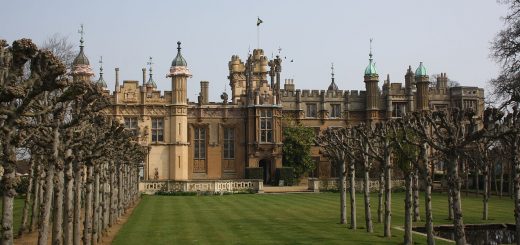Church of St Mary-in-the-Baum, Rochdale
The present Church of St. Mary-in-the-Baum dates from 1911 and is a Grade II listed building. It replaced an earlier Church of St Mary built in 1742, which by the start of the 20th century was considered cheaper to replace than repair. The term Baum is local dialect speech for Balm, referring to the medicinal herb, Melissa officinalis, (Lemon Balm, Balm or Balm Mint), that grew in the fields around where the church was erected and being used locally by herbalists in the 18th century.
According to local tradition, the area around the church was haunted by the ghost of a white rabbit, called the Baum Rabbit. The following description of of the original St Mary’s Church and the phantom rabbit is taken from ‘Rochdale Past and Present; a History and Guide, by William Robertson (1876)’.
 This place of worship is situated in Cheetham Street, and was best known in bygone years as “Baum Chapel.” It is not now often so called; its more modern name was “St. Mary, the Virgin,” but, no doubt, for some good reason the second part of the title has been dropped, and it is at present called “St. Mary’s.” It was erected about 1744, and the outward appearance of the building, which is of brick, is not handsome. It has recently undergone considerable improvement and decoration internally, and the wonder really is that so much could be done with such unpromising materials as presented themselves. Great credit is due to those by whom the alterations and beautifying have been carried out. The mode of conducting divine service at St. Mary’s is decidedly high; and the present Vicar’s Ritualism is well known. How far High Church practices conduce to godliness admits of considerable doubt. The Legislature has expressed its mind on the subject by passing the Public Worship Act of 1874; and, probably, when that statute comes into operation people will see less of the “mass in masquerade,” and its accompanying clerical millinery, than previously.
This place of worship is situated in Cheetham Street, and was best known in bygone years as “Baum Chapel.” It is not now often so called; its more modern name was “St. Mary, the Virgin,” but, no doubt, for some good reason the second part of the title has been dropped, and it is at present called “St. Mary’s.” It was erected about 1744, and the outward appearance of the building, which is of brick, is not handsome. It has recently undergone considerable improvement and decoration internally, and the wonder really is that so much could be done with such unpromising materials as presented themselves. Great credit is due to those by whom the alterations and beautifying have been carried out. The mode of conducting divine service at St. Mary’s is decidedly high; and the present Vicar’s Ritualism is well known. How far High Church practices conduce to godliness admits of considerable doubt. The Legislature has expressed its mind on the subject by passing the Public Worship Act of 1874; and, probably, when that statute comes into operation people will see less of the “mass in masquerade,” and its accompanying clerical millinery, than previously.
While speaking of this church, we must not forget to mention the “Baum Rabbit.” Whether any of the present generation have seen that ghostly rodent, we will not undertake to say. In former days, or rather nights, it used to “revisit the glimpses of the moon” in the chapel yard. It was a rabbit of robust and lively habits; and was plump and well nourished, as if the churchyard herbage agreed with it. It was always beautifully clean, and was even said to be ” whiter than snow.” It used to be seen in various attitudes; sometimes standing on its hind-quarters, after the manner of the rabbit kind, and demurely brushing its whiskers. Its aspect was usually somewhat serious, although, at times it had a comical twist of countenance. It has, also, been observed delving into the churchyard mould with great determination, as if in search of hidden treasure. But no one, that we have heard, ever came to close quarters with it. The slightest attempt to hold a parley with the mysterious quadruped was utterly useless; for, being exquisitely sensitive to the slightest sound, it invariably disappeared into thin air when intruded upon, and thus eluded the investigations of the earnest enquirer after truth. Strange to say, it was, apparently, much pleased with the love (but not lovely) music of the feline tribe, to which it listened with mute attention. Clearly, the rabbit was invulnerable to the nocturnal sportsman’s small shot, and even air-guns, it is alleged, had no effect on it. After a discharge from any deadly weapon, it used to reappear with the greatest equanimity, and frisk about as if to encourage, its assailants to further effort in the same direction. Some people said the smell of the gunpowder was as delicious to it as a pinch of snuff is to an old woman. It was “generally admitted ” that it was a rabbit of a ghostly or supernatural character. The story runs that hundreds of years before the erection of “Baum Chapel,” a “deed of horror” was committed within the precincts haunted by this extraordinary rabbit; but, unfortunately, authentic particulars of that dark transaction have never been obtained, and we are, therefore, unable to gratify the reasonable curiosity of the reader on the subject. It is agreed on all hands that, as a rabbit, it was remarkably well-behaved, and never, so far as could be ascertained, committed any serious wrong. Its chief object seemed to be to “scare folks a bit” and it gave no token of being influenced by any diabolical agency. “Doomed to walk” or, rather, haunt the churchyard for a certain term, it would seem, from recent experience, that it has performed its allotted task, for very little is heard in our day of the surprising “Baum Rabbit” which used to perplex the natives, and fright them from their propriety. It is with reference to this curious animal that an ancient local poet, in an angry mood, wrote the verses which we subjoin. He had to pass through the churchyard every night on his way home, and was, to say the least, of a very nervous temperament.
Confound that rabbit!
I wish some chap would grab it,
And stop its nightly habit;
Confound that rabbit!
Confound its head and eyes !
Confound its legs and thighs !
Confound it otherwise!
Confound that rabbit!
Dogs, rush out and squeeze him!
Worry, toss, and teaze him!
That is, if you can seize him!
Confound that rabbit!
As to its disappearance, we confess ourselves unable to solve the query which has been submitted to us, whether the rabbit can have been caught by some wight more expert than his fellows, and converted into rabbit pie.
It may be right to add that if our legend of the “Baum Babbit” is new to our readers, it is only a proof that people may live and learn. As we have said, it is difficult at this great distance of time to obtain authentic particulars; but we will venture to back our story against any other that can be produced, and, what is more, we are quite certain that ours is entitled to be regarded as being equally truthful.
The paranormal Database also refer to the ghostly figure of a man drifting in the churchyard.




Recent Comments